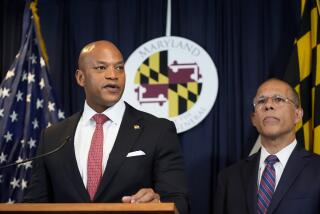Caltrans Blames Manufacturer for Bridge’s Collapse
- Share via
SANTA ANA — A Caltrans inquiry has tentatively concluded that the manufacturer of a temporary bridge near Lompoc was responsible for the span’s collapse six weeks ago, but serious questions remain about the agency’s culpability in the dramatic failure, a state senator said Thursday.
The temporary bridge on a stretch of California 246 caved in just seconds after a nearly 90-ton truck crossed it, sending the next vehicle on a harrowing slide to the creek bed 30 feet below. No one was injured in the mishap.
In a preliminary report issued this week, Caltrans officials said the bridge they received was not the one they ordered and placed fault for the collapse with the bridge’s New Jersey-based manufacturer, Acrow Corp. of America. The report said Caltrans purchased a bridge that should have been capable of handling heavier loads.
Acrow officials fiercely disputed that claim Thursday, contending in a prepared statement that Caltrans’ report “contains blatant inaccuracies, misstatements and deceptive and incomplete technical points.”
The latest dispute involving Caltrans comes during a year in which the agency has been embroiled in controversy over bridge welds, the sinking Century Freeway and an error-prone truck-permitting office that was responsible for a fatal accident involving an oversized truck. State Sen. Joe Dunn (D-Santa Ana) said the problems indicate that the time has come for wholesale restructuring of the department.
“I’d describe the management style as ‘We won’t do anything to prevent problems and then we’ll find someone else to blame when something bad happens,’ ” Dunn said. “It’s crossing your fingers and hoping nothing goes wrong.”
Caltrans officials say that characterization is unfair. They say that they believed the 190-foot-long bridge they ordered could handle the weight they put on it while a storm-damaged bridge was under repair.
At least six trucks weighing more than the legal limit of 38 tons crossed the span, including the final 89-ton rig hauling a mammoth excavator that barely cleared the bridge before it failed.
Dunn said Caltrans’ own report indicates that agency officials had several opportunities to prevent the accident. A Caltrans engineer warned before the bridge was built that the design might not be able to handle heavy loads. But Caltrans officials signed off on the plans without fixing the problem, the report says.
More dramatically, on Oct. 21, the morning of the collapse, a bridge inspector noticed a bent steel truss on the bridge and notified Caltrans bridge experts in Sacramento.
What happened next is in dispute. Caltrans officials said they e-mailed photos of the problem to Acrow engineers in New Jersey, consulting with them before determining that the “structure was in no danger of failure,” the report said.
Acrow officials, however, said they received pictures of the problem after the bridge had already collapsed and never signed off on the structure’s safety that day.
Meanwhile, unaware even that a temporary bridge had been installed, a Caltrans truck permit writer in San Bernardino approved the route over the temporary bridge for the rig carrying the excavator--more than an hour after the bent steel was found, Caltrans documents show.
Oversized trucks were routed with no restrictions on their speeds or the manner in which they crossed the temporary span, conditions the bridge’s manufacturer says are essential for safety.
The 89-ton truck was going 55 mph before the collapse, according to the accident report by the California Highway Patrol. Acrow officials say a truck of that size should have been going no faster than 5 mph down the center of the bridge to avoid structural damage.
In a news release, Caltrans Director Jose Medina said the collapse occurred because Caltrans did not receive the temporary bridge it ordered.
“Our oversight process did not catch that mistake, but the responsibility rests with the manufacturer and its licensed engineer that signed and sealed the structural plans for the temporary bridge,” he said.
A final report on the collapse may still be months away, Caltrans officials said.
More to Read
Sign up for Essential California
The most important California stories and recommendations in your inbox every morning.
You may occasionally receive promotional content from the Los Angeles Times.














